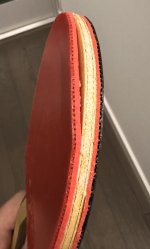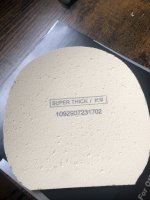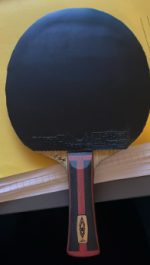This user has no status.
Member
This is something I had only learned about today, even after being an equipment nerd for a good while, so I thought this might help someone else out here too.
Not too long ago, someone was talking about their method of gluing rubber using thicker glues on this forum (sorry, I can't remember who it was, but all the credit goes to them!).
They mentioned that to make it easier to apply the glue, they used a damp sponge, which helped dilute the glue ever so slightly, as well as start with a sponge that absorbs less of the glue which leads to a more even glue job.
I had to reglue my rubber, so I decided to try this method. Wet the sponge under some water, squeezed it to keep just a little bit of water inside, and then glued my rubbers. 2 layers on the sponge, 1 layer on the wood, like I always do. It definitely helps spread the glue more evenly, gives more time before the glue starts drying, and results in a thinner layer of glue.
Decided to weigh my blade afterwards too. Before, it was 189 grams, and was a little bit too head-heavy for me. Using this method with significantly thinner layers of glue, it now weighs 180 grams. 9 grams of difference, and it's all cut from the head! I never used a lot of glue to begin with, as I've tried to keep it as thin and even as possible, but this kind of difference is massive and unexpected.
Not too long ago, someone was talking about their method of gluing rubber using thicker glues on this forum (sorry, I can't remember who it was, but all the credit goes to them!).
They mentioned that to make it easier to apply the glue, they used a damp sponge, which helped dilute the glue ever so slightly, as well as start with a sponge that absorbs less of the glue which leads to a more even glue job.
I had to reglue my rubber, so I decided to try this method. Wet the sponge under some water, squeezed it to keep just a little bit of water inside, and then glued my rubbers. 2 layers on the sponge, 1 layer on the wood, like I always do. It definitely helps spread the glue more evenly, gives more time before the glue starts drying, and results in a thinner layer of glue.
Decided to weigh my blade afterwards too. Before, it was 189 grams, and was a little bit too head-heavy for me. Using this method with significantly thinner layers of glue, it now weighs 180 grams. 9 grams of difference, and it's all cut from the head! I never used a lot of glue to begin with, as I've tried to keep it as thin and even as possible, but this kind of difference is massive and unexpected.












